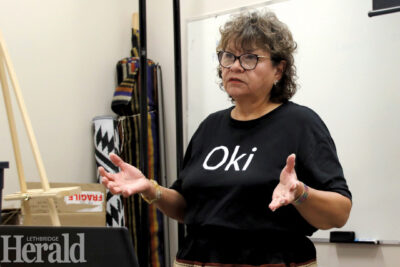Blackfoot women had key roles in pre-colonial society
By Alexandra Noad - Lethbridge Herald Local Journalism Initiative Reporter on July 16, 2024.
 Herald photo by Alexandra Noad
Mary Fox (Mia'nistsitsiiksiinaakii) spoke about the history of Blackfoot women's roles recently at Fort Whoop-Up.
Herald photo by Alexandra Noad
Mary Fox (Mia'nistsitsiiksiinaakii) spoke about the history of Blackfoot women's roles recently at Fort Whoop-Up.Before colonialism, Blackfoot women were respected and considered as equal to men.
Mary Fox (Mia’nistsitsiiksiinaaki) made a presentation on Blackfoot women last week at Fort Whoop-Up.
Fox currently is a professor in the Indigenous Studies department at the University of Lethbridge.
In the presentation Fox spoke about how women played significant roles in both domestic and economic areas.
“They were responsible for the caring of the family,raising kids, raising children, preparing food, making clothing,” said Fox
She added that findings on the Blackfoot people suggest they were the best child rearing people.
Unlike in early Western societies, Blackfoot women also played a large role in decision making and often participated in tribal council.
“The women also had they had a say in decision making. And that’s one of the particularly significant processes in the patriarchy groups within their communities and often participating in tribal councils,” said Fox.
When colonization came into effect, everything changed for the Blackfoot people, but especially the women.
When European settlers arrived to Canada, they also brought their Patriarchal beliefs.
“Policies were created throughout the country and with the goal of assimilating and so-called civilizing First Nations peoples based on European models,” said Fox.
Because of these policies, Indigenous women often face challenges that their non-Indigenous counterparts don’t face.
“Indigenous women and frequently experience challenges and that’s still happening in discrimination that are not necessarily shared with non-Indigenous women,” said Fox.
Fox also added that white women were responsible for the infertilization of Indigenous women.
“From my knowledge non-Indigenous women were very much responsible for the process of infirtiling women…a lot of the farmers wives, that was basically, I could say, their mission,” said Fox
When the Indian Act was first implemented in 1876, the lineage of the Indigenous was sole through the men, meaning if an Indigenous woman married a non-Indigenous man both the woman and her children were denied status. This policy was in effect until 1985, 116 years after the Indian act was enforced.
She said the first attempt at making the Indigenous people disappear was providing them alcohol. Since alcohol was not apart of their culture, many Indigenous people died upon drinking it for the first time.
“First, it was alcohol that the Europeans must try to make us disappear. One of the ingredients was put into to the alcohol to kill us. And so when that happened and my ancestors make that first drink, they actually drop dead right there.”
She said the Europeans also brought foreign diseases, which were passed along through the blankets they traded, said Fox.
“They brought their diseases through the blankets.”
When neither the alcohol or the diseases eradicated the Indigenous people, the residential school system was formed to “kill the Indian in the Child,” she said.
The residential schools taught the young children, specifically the young boys, there has to be a dominate person in the family which was the mans job.
Because of the intergenerational trauma this caused domestic violence, which Indigenous women are still suffering with today, said Fox.
Fox says it is critical for all Indigenous people to heal from the trauma to stop the cycle of domestic violence.
“There are some men that are coming to heal, so that they are determined to stop domestic violence on their spouses and their children but, some of the elders that have come through and have managed to heal because they turn to their traditional teachings.
Fox believes all people, especially non-Indigenous people, can benefit in learning from Blackfoot teachings.
27-26


